Best telescopes for kids 2024: Top picks for young skywatchers
This is our guide to the best telescopes for kids and teenagers. We cover a range of small and lightweight models suitable for all budgets.

1. The list in brief ↴
2. Best tabletop telescope
3. Best quality for beginners
4. Best for younger users
5. Best for viewing planets
6. Best for exclusively lunar viewing
7. Best for teens
8. What to look for
9. Best kids telescopes FAQ
10. How we test
One of the best telescopes for kids is the perfect way to nurture your children's interest in stargazing and astronomy. Unlike toy telescopes, these are fully functional models that we have selected for their compact size, light weight, sturdiness, and ease of use. They work like larger adult models but are more suited to smaller hands and eyes. They have been designed with beginner stargazers in mind to help them hone their skills from a young age.
We've included various models on this list to cover different ages and budgets. Younger children are likely to need something simple, straightforward to use and robust enough to withstand a few knocks, while older children and teenagers may be looking for something that's a bit more technically capable. All of the telescopes on this list have been tried and tested by our reviewers and their families, taking into account all their pros and cons to arm you with the information you need to decide on the best one for you.
If you're looking for further options, there are other models that would be suitable for older kids and teenagers in our best beginner telescopes and best telescopes under $500 guides. If your child would prefer something more portable for viewing the night sky, check out our guide to the best binoculars for kids that are easy to travel with.

A contributing expert to Space.com, Live Science, All About Space and more, Gemma is the author of several books including 'Quantum Physics in Minutes'. She holds a degree in physical sciences, a Master's in astrophysics and a PhD in computational astrophysics and became fellow of the Royal Astronomical Society in 2011. Gemma is also the Communications and Outreach Office at the European Space Agency.
The quick list

Best tabletop telescope
The FirstScope is a great tabletop telescope, ideal for young astronomers and absolute beginners. It's easy to set up and put away, but it's not the most powerful.
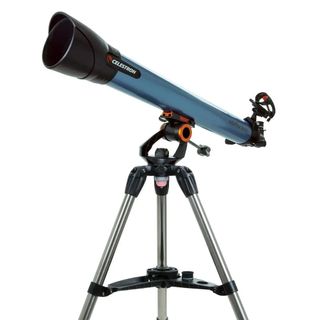
Best quality for beginners
The Celestron Inspire 80AZ is a high quality telescope that goes above and beyond most beginner scopes. It's easy to assemble and use, and it'll last a long time.
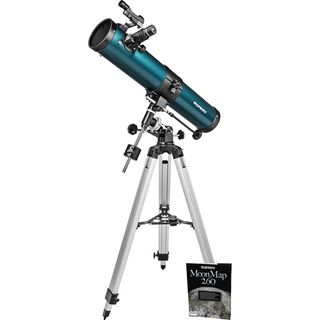
Best for younger users
The Orion SpaceProbe II 76 is a great choice for younger users — although it's good enough to be used by the whole family. It's ideal for taking camping.
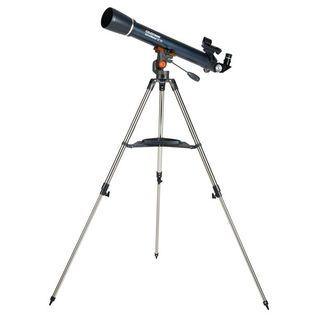
Best for viewing planets
The Celestron AstroMaster 70AZ is a very good starter telescope. It's not great for deep sky viewing, but it'll provide some great views of the Moon and planets.
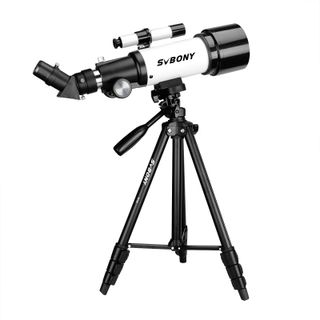
Best for exclusively lunar viewing
The SVBONY 501P 70 is a great, affordable choice for viewing the Moon, but be sure to keep an eye on the price because it can fluctuate a lot.
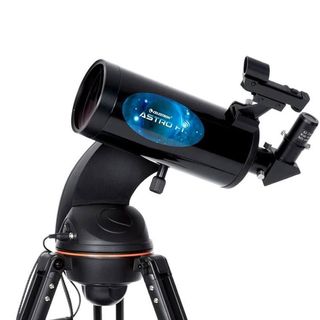
Best for teens
This is a great telescope that gives wonderful views of the night sky, but setting it up can be a little tricky, so we'd recommend it for older children rather than the youngest stargazers.
Best telescopes for kids we recommend in 2024
Why you can trust Space.com
Best tabletop telescope
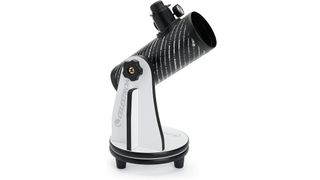
Specifications
Reasons to buy
Reasons to avoid
✅ You want low investment: For casual viewing, this telescope is a great option with a low price point.
✅ You don't want to spend ages setting it up: It arrives assembled and ready to go, so no complicated setup process needed.
❌ You want to find objects easily: It doesn't come with a finderscope, so anyone wanting to locate certain celestial objects easily may get frustrated.
❌ You want all the extras: This package doesn't include a finderscope, so you'll need to either buy one separately or consider another telescope package that does.
🔎 Celestron FirstScope 76 Tabletop Telescope If you have children who have been bugging you for a telescope and you can't quite commit to a moderately-priced instrument, then the FirstScope may be for you — especially if the Moon and casual glances at the night sky are of interest. ★★★★
As the name suggests, the Celestron FirstScope 76 is designed as a first telescope, which makes it ideal for kids because it comes out of the box fully assembled and ready to use. We thought the build felt very robust, and at 4.3 lbs (1.95kg), it's eminently portable and sits neatly on a table at home. It's also one of the most affordable scopes on the market, making it an excellent gift for younger kids to get their first glimpses of the night sky if you're unsure how long their interest in it may last.
In terms of optics, you're getting a Newtonian reflector with two eyepieces: a 20mm, which provides 15x magnification, and a 4mm, which provides 75x magnification. We advise investing in additional eyepieces to get the very best out of the 180x highest useful magnification. Unfortunately, the telescope is missing a finderscope to aid in navigation and alignment, making star-hopping particularly tricky, so we'd also recommend investing in a red dot finder for your telescope. Fortunately, these are relatively inexpensive to buy.
While it can't compete with more expensive telescopes, the views through this scope are still likely to thrill young stargazers. They'll be able to spot craters on the surface of the Moon and spy Jupiter surrounded by its Galilean moons: Io, Ganymede, Europa and Callisto. Saturn appears relatively faint and fuzzy, but you can still just about make out its rings and yellow coloration. The fast focal ratio and wide-angle view also make it ideal for spotting star clusters like Pleiades (Messier 45) in the constellation of Taurus, since all these points fit neatly into the field of view.
Overall, this telescope's sturdy build, straightforward nature, and friendly price point make it a great choice for a kid's first scope, but more experienced stargazers will want to upgrade to something more powerful quite quickly.
- Read our full Celestron FirstScope 76 Tabletop telescope review
| Attributes | Notes |
|---|---|
| Design | Good quality build for the price. |
| Performance | Provides a 'wow factor' for young observers. |
| Functionality | Optics struggle to pick out detail. |
Best quality for beginners





Specifications
Reasons to buy
Reasons to avoid
✅ You want easy setup: We found this telescope to be very easy to set up and use, getting you stargazing in no time.
✅ You'll be traveling with it: As it's so portable and lightweight, it's very easy and convenient to take outside of the home, on camping trips or for long nights of stargazing.
❌ You're on a tight budget: This isn't the cheapest telescope on this list, however, it is better quality than the cheaper ones.
❌ You're not a beginner: This telescope is definitely geared more towards beginners, so we'd recommend going for something more advanced if your skills are further along.
🔎 Celestron Inspire 80AZ An excellent telescope for a beginner — especially given that a complete package is offered, exudes portability and is easy to use and set up. ★★★1/2
For children who like the idea of more traditional astronomy without the aid of modern technology, we highly recommend the Celestron Inspire 80AZ. This is a great starter telescope for kids and adults alike, but it's particularly suitable for youngsters looking to take stargazing seriously.
The telescope comes with an alt-azimuth mount and a user-friendly panning handle for precise movements, making it easy to focus on specific celestial targets. Unlike other mounts that can cause sudden shifts, this telescope allows for smooth and gradual adjustments to the tube's position.
We'd recommend that an adult who knows what they're doing offer some support to younger users, though. Navigating the night sky and grasping the basics involves a bit of a learning curve.
That said, the Celestron Inspire 80AZ is a great starting point, and in the box, you'll find everything you need to begin. There's a solid tripod, two eyepieces (20mm and 10mm, providing 45x and 90x magnification), a StarPointer Pro red-dot finderscope, an LED flashlight (to preserve night vision), and a software download of Celestron's Starry Night Basic Edition.
There's also a smartphone adapter, which allows users to take photographs of their astronomical discoveries with their phone. It's unnecessary but a neat touch, and is likely to be particularly useful for younger users who may want to share the neat things they've seen in the night sky with their friends.
In our review of the Celestron Inspire 80AZ, we unfortunately found a small amount of chromatic aberration around the brightest targets in the night sky. In other words, color fringing around certain objects. Considering the price point of the telescope, though, it's not too concerning and doesn't interfere too much with the views the Inspired 80AZ can provide. On the whole, we loved the clear views, particularly Jupiter and its belts. We also got to glimpse the ice giant Uranus.
The 3.15-inch (80 mm) aperture made short work of picking out Starbirth at the center of the Orion Nebula (Messier 42), while magnified pin-sharp views of the Hyades star cluster in Taurus dazzle through the optical system.
The Inspire range is also available in apertures of 2.76 inches (70mm) and 3.14 inches (100 mm). If you're looking for an instrument that will take a few years to outgrow, the Inspire 80AZ is the ideal choice.
- Read our full Celestron Inspire 80AZ review
| Attributes | Notes |
|---|---|
| Design | Complete observing package. |
| Performance | Clear views, with false color observed. |
| Functionality | Easy-to-use smartphone adapter. |
Best for younger users
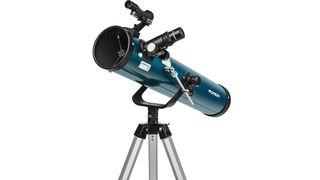
Orion SpaceProbe II 76
Our expert review:
Specifications
Reasons to buy
Reasons to avoid
✅ The whole family will use it: This telescope is user-friendly and good for users of all abilities.
✅ You want to travel with it: It's incredibly lightweight, so you can take it on camping trips or to dark sky sites as well as using it in your backyard.
❌ You're serious about astronomy: As we found the views are not 100% sharp across the frame, and its general beginner-friendly feel, it's best suited to younger users or anyone who isn't sure if it's a long-term hobby.
🔎 Orion SpaceProbe II 76 Particularly suited to skywatchers younger than ten. It would also work well for beginners who are new to skywatching and unsure if it will be a long-term hobby. ★★★
While the Orion SpaceProbe II 76 might not be the best choice for users more serious about astronomy, we've found it to be a great option for youngsters just getting started. As a reflector telescope, it's perhaps the best kind for beginners thanks to its innate light-gathering power. Indeed, we've found that this particular scope collects up to 60% more light than similar beginner scopes. Considering it costs less than $100, that's a real achievement.
The Orion SpaceProbe II provides an aperture of 2.99 -inches (76mm), which — like the aforementioned Celestron FirstScope — will reveal the solar system, lunar surface and a selection of bright deep-sky targets.
Weighing 7.05 lbs (3.2kg), it's not the absolute lightest telescope on the market, but it's still very portable—whether you're just moving it into the backyard or taking it on a camping trip, it's easy enough to carry or pop in the car. Despite its comparative lightness, it's still plenty sturdy: Its steel tube construction is durable, so you won't have to worry about the odd knocks and bumps.
Out of the box, the Orion SpaceProbe II can provide magnification levels of 28x and 70x, but with additional accessories that can expand up to 152x. It also comes with two eyepieces (10mm and 25mm), a red dot finder and a moon map. The red dot finder is seriously useful in simplifying star hopping, and it's a major plus that one's included in the box here.
We love the wide-field views offered by the Orion SpaceProbe II. It's great for viewing objects like nebulas and star clusters, but you'll really get the most out of this telescope when viewing moons and planets.
We should probably mention that, because of the SpaceProbe II's spherical mirror, the views aren't completely sharp, and that's why we wouldn't necessarily recommend it for more seasoned astronomers. For youngsters just getting started, though, getting up close and personal with Saturn or the Moon's craters is bound to be pleasing.
We'd recommend the Orion SpaceProbe II for newcomers to astronomy under the age of ten. If you're older and want a cheap, inexpensive place to start, this can also be a decent option thanks to its low price point.
- See our Best eyepieces for telescopes guide for optional upgrades
| Attributes | Notes |
|---|---|
| Design | Lightweight and portable design. |
| Performance | Red dot finder makes star-hopping easy. |
| Functionality | Offers wide field views for many different objects. |
Best for viewing planets







Specifications
Reasons to buy
Reasons to avoid
✅ You have a small budget: This telescope is very affordable, although you do get what you pay for.
❌ You want something that's going to last: We noted in our review that it wouldn't be enough to hold the interest of beginners for a long time.
❌ You want to see deep-sky objects: While you can see some deep-sky objects, we found them to appear quite dull, so we'd recommend looking elsewhere.
🔎 Celestron AstroMaster 70AZ: This lightweight chromatic refractor uses its relatively long length to produce natural-looking views of planets and the Moon, but for anything else it's underwhelming. It's also quite difficult to lock onto targets. ★★★
The Celestron AstroMaster 70AZ is a 2.7-inch (70mm) achromatic refractor telescope aimed squarely at beginners looking to get great views of objects within our solar system. It features an unusually long 35-inch (900mm) tube, which it uses to create a focal ratio of f/13. The benefit of this is that it doesn't suffer from the chromatic aberration, or 'false color,' that is common to other achromatic refractor beginner telescopes, enabling it to offer true-color views of the Moon and planets without any purple or pinkish haloes around them.
This telescope is a complete kit. It comes with an adjustable tripod that can be used at full or half height, a StarPointer finderscope to help with alignment, and an L-shaped erect image diagonal that makes it easier to use the telescope while standing upright. You also get two Kellner eyepieces—a 20mm eyepiece for wide-angle views at 45x magnification and a 10mm eyepiece for high-powered views at 90x magnification.
As expected at this price point, this is a manual telescope, but we were pleased to see that it features a panhandle with a clutch for securing it in position and adjusting the field of view. Unfortunately, while it's straightforward to set up, it can be tricky to aim the telescope and lock onto targets due to a bit of overreach and recoil.
You can get nice, natural-looking views of the Moon and planets, allowing you to pick out Saturn's rings and some of Jupiter's moons. Still, the focal ratio of f/13 doesn't allow enough light in for good views of deep-sky objects like the Andromeda Galaxy (M31). It is, therefore, most suited to beginner astronomers looking for realistic views of our solar system.
- Read our full Celestron AstroMaster 70AZ review
| Attributes | Notes |
|---|---|
| Design | Lightweight design. |
| Performance | No 'false color', but dull deep-sky objects. |
| Functionality | Difficult to lock on to targets. |
Best for exclusively lunar viewing






Specifications
Reasons to buy
Reasons to avoid
✅ You don't want to spend a lot: This telescope is incredibly affordable, particularly if you're unsure whether it'll be a hobby your child continues with.
✅ You want to see the Moon: This telescope provides good lunar views, though not much else.
❌ You're serious about astronomy: While great for lunar viewing, this telescope isn't suited for much else, nor is it that powerful.
🔎 Encalife SVBONY 501P 70: If you want a small and affordable telescope for a child to primarily look at the Moon and not much else, the SVBONY 501P 70 just about fulfils that brief. ★★★
The Encalife SVBONY 501P 70 telescope is one of the most affordable scopes on this list, so don't expect its capabilities to blow you away. That said, if you have a child who is largely interested in viewing objects in our solar system — particularly the Moon — it's a very good choice.
The SVBONY 501P 70 is perhaps one of the most barebones telescopes on this list. But we don't necessarily mean that in a bad way. It's straightforward and uncomplicated, and those two things make for an excellent starter telescope for stargazing youngsters.
This is a 2.75 refractor telescope, which comes mounted on a compact and lightweight tripod. Everything that comes with the scope fits inside an included travel bag, which makes it ideal for slinging over your shoulder when heading out on a camping trip or placing it in the back of the car.
In our Encalife SVBONY 501P 70 telescope review we praised the great views of the Moon that the 400mm focal length will give, but noted that the telescope has very limited potential. If your child wants to delve deeper into space, this isn't the scope for them.
At the moment, this scope is only available directly from the Svbony website. However, we've historically seen it on Amazon for as low as $50, we wouldn't recommend paying more than $80.
- Read our full Encalife SVBONY 501P 70 telescope review
| Attributes | Notes |
|---|---|
| Design | Very lightweight, but not great quality. |
| Performance | Decent views of the lunar surface, but struggles with everything else. |
| Functionality | Lots of droop and overreach, lacks fine controls. |
Best for teens





Specifications
Reasons to buy
Reasons to avoid
✅ You want alignment technology: The SkyAlign technology makes aligning your telescope a breeze, all at the touch of a button.
✅ You want something portable: This telescope is lightweight and easy to transport, making it a great option to take on camping trips to dark sky sites.
❌ You don't want technology: This telescope requires the use of its app in order to function, so users looking for a more traditional approach should look elsewhere.
🔎 Celestron AstroFi 102 A basic telescope best suited to lunar and planetary observation. The motorized mount can initially be tricky to set up for beginners, but it comes at a reasonable price for a decent night sky view ★★★½
The Celestron Astro Fi 102 is an excellent value for money telescope. It combines advanced technology, great customer support and portability, resulting in a solid telescope that's great for beginner and tech-savvy skywatchers.
You'll get everything you need to begin right out of the box. The Celestron Astro Fi comes with 10mm and 25mm eyepieces (offering magnifications of 132x and 53x), a red dot finder and a smartphone adapter (perfect for trying out astrophotography for beginners). The best part is this all comes in a lightweight package, making this a telescope that's easily transported.
Naturally, given the price point of the Astro Fi 102 telescope, some corners have been cut in order to keep it light. That means it's got external plastic casing rather than metal, so it's not as robust as some other telescopes on the market. It does keep the cost down along with its weight, though, and as long as you take good care when moving it around it shouldn't pose any issues.
In our Celestron Astro Fi 102 review, we praised the great views provided by the optics and noted how great it was in particular at providing excellent views of Venus, Mars, Jupiter and Saturn. Its four-inch aperture is great for getting clear, detailed views of the Moon's terrain too. We also used it to gaze at the Andromeda Galaxy, and playing with the magnification a little allowed us to see its disk too.
Perhaps our favorite thing about the family-friendly telescope, though, is that is makes use of Celestron's proprietary SkyAlign technology. By using your smartphone and the Celestron SkyPortal app, you can automatically align your telescope to the night sky. In other words, the app will determine your position in the world, making it easy to point you towards any visible object in the night sky. It's a fantastic piece of technology that makes viewing celestial objects not only super easy, but a great deal of fun.
- Read our full Celestron AstroFi 102 review
| Attributes | Notes |
|---|---|
| Design | Basic plastic casing, tripod needs weighing down. |
| Performance | Seamless syncing with the SkyPortal App. |
| Functionality | Quiet operation and reliable integrated Wi-Fi. |
What to look for
Kids telescopes are still an intricate piece of kit, so there are a few things to consider when choosing one.
First and foremost is probably the price. Chances are, if you're buying a telescope for a child or teenager, it's their first venture into astronomy, so you won't want to spend a fortune if you're not sure they'll take to skywatching.
While telescopes for kids work just like standard ones, you'll want to make sure the model you choose is easy to put together and intuitive to use to make it easier for them. Of course, you'll also want to supervise children while they skywatch and teach them how to use the telescope.
The first thing to consider when buying a good kids telescope is the price. It's likely if you're buying a telescope for a child or teen, they're brand new to astronomy — you don't want to spend a fortune on something that might not become a serious hobby.
Functionality is another important consideration. You can choose either a traditional telescope, or a GoTo one that has motorized functions and app support. Both are great and reliable options, but you'll want to choose one depending on yours and your family's preferences.
Choosing a sturdy telescope is probably a good move when buying one suitable for kids. However, the most robust models can also cost a pretty penny, so there's a fine balance between finding a telescope that can handle being used by kids and one that won't break the bank.
All of these considerations were taken into account when we reviewed telescopes and ranked them in this guide. We've made sure to include a range of telescopes with different functions and at different price points, so you'll be sure to find a model that works for you.
Best telescopes for kids Frequently Asked Questions
What is the best telescope for kids?
Our top pick for the best telescope for kids is the Celestron Inspire 80AZ. We loved the fact it is simple to put together and easy to operate, but also that it comes with plenty of accessories. It even gives you the ability to take basic pictures with your smartphone.
The Celestron FirstScope 76 is the best tabletop scope, in our opinion, but we've had to replace it with the Sky-Watcher Explorer 130 EQ2 in our guide as it was often out of stock. If you can find the Sky-Watcher Explorer, it's a great choice for kids - it has a really sophisticated tracking ability and comes at a reasonable price.
What makes a telescope good for children?
Choosing the best telescope for kids starts with establishing what they might want to observe. This will then help you determine whether to go for a refractor, reflector or a catadioptric telescope.
A refractor telescope is the best option to observe the Moon or planets, which require high magnification. As an added bonus, these telescopes tend to be small, lightweight, easier to operate and cheaper than others.
On the other hand, if you want to observe fainter objects such as nebulas or distant galaxies, you might want to opt for a reflector telescope due to their light-gathering capabilities.
Catadioptrics are a hybrid between refractor and reflector telescopes, and they come in two forms: Schmidt-Cassegrain and Maksutov-Cassegrain. This type of telescope tends to be most user-friendly and modern than some of the others, and they're usually computerized, so they're great for viewing a wide range of objects.
Are catadioptric telescopes expensive?
Catadioptric telescopes are usually computerized so they tend to be more expensive than other types of telescopes. For that reason, if your child is new to skywatching, we'd recommend starting with a different, cheaper type of telescope, in case they don't take to the hobby. However, if you think you want a catadioptric telescope, you can find some in our best beginner telescopes guide.
What's the best telescope for the whole family?
While the best telescopes for kids are fully functional telescopes, you might want to opt for a slightly more sophisticated model that works for the whole family. Our guide to the best telescopes guide has plenty of options for a range of budgets and abilities. The best binoculars are a cheaper alternative and can still deliver great views of the night sky.
How do I choose a telescope for my child?
When choosing a telescope for kids, we'd recommend you steer clear novelty models and cheaper models. Investing in a reliable telescope means you'll be guaranteed good quality optics, and children are more likely to enjoy skywatching sessions.
How old should a child be to use a telescope?
There is no set age to start using a telescope. In theory, as long as your child has good eyesight and good enough motor skills to look through an eyepiece, they can use one. Of course, for kids under the age of six or even will need adult supervision while they are stargazing. Over that age, it's still advisable to keep both the child and telescope safe.
How we test
Here at Space.com, we review each telescope to ensure that our recommendations for the best telescopes to buy are honest and current. Our reviews are based on various criteria, including construction and design, optical function, and field performance.
Aperture: The diameter of the primary mirror or lens that allows a telescope to gather light.
Field of view: Area of sky visible through the eyepiece.
Focal length: A telescope's tube length. Short focal lengths offer a wide field of view and a small image.
Focal ratio: Also known as the telescope's speed. Small focal ratios provide lower magnifications, a wide field of view and a brighter image.
Magnification: Relationship between the telescope's optical system and the eyepiece.
Each telescope is carefully tested by our expert staff or knowledgeable freelance contributors who know their subject areas in depth. This ensures fair reviewing is backed by personal, hands-on experience with each telescope and is judged based on its price point, class and destined use. For example, comparing a 10-inch Dobsonian to a 2.76-inch refractor wouldn't be appropriate though each telescope might be the best pick in their own class.
We look at how easy it is to set up, whether computerized or motorized mounts are reliable and quiet, and if the telescope comes with appropriate eyepieces and a functional tripod. We also suggest wether a particular telescope would benefit from any additional kit to give you the best experience possible.
With complete editorial independence, Space.com are here to ensure you get the best buying advice on telescopes, whether you should purchase an instrument or not, making our buying guides and reviews reliable and transparent.
Join our Space Forums to keep talking space on the latest missions, night sky and more! And if you have a news tip, correction or comment, let us know at: community@space.com.
Get the Space.com Newsletter
Breaking space news, the latest updates on rocket launches, skywatching events and more!

Gemma currently works for the European Space Agency on content, communications and outreach, and was formerly the content director of Space.com, Live Science, science and space magazines How It Works and All About Space, history magazines All About History and History of War as well as Science, Technology, Engineering, Arts and Mathematics (STEAM) kids education brand Future Genius. She is the author of several books including "Quantum Physics in Minutes", "Haynes Owners’ Workshop Manual to the Large Hadron Collider" and "Haynes Owners’ Workshop Manual to the Milky Way". She holds a degree in physical sciences, a Master’s in astrophysics and a PhD in computational astrophysics. She was elected as a fellow of the Royal Astronomical Society in 2011. Previously, she worked for Nature's journal, Scientific Reports, and created scientific industry reports for the Institute of Physics and the British Antarctic Survey. She has covered stories and features for publications such as Physics World, Astronomy Now and Astrobiology Magazine.
- Jase Parnell-BrookesChannel Editor
- Kimberley LaneContributing writer
- Kimberley SnaithFreelance contributor
-
rod A few notes from me. Buy a telescope that uses 1.25 inch focuser or 2 inch size. These are expensive but provide much better views than focusers that work with 0.965 inch eyepieces. A big problem for many folks using telescopes - the ability to locate a target in the sky and view in the eyepiece. Over the years I see this as a common frustration with first time telescope buyers. You can solve issues here with Intelliscope or GoTo scope technology but these systems are usually - very expensive. Refractor telescope is easier to work with vs. a reflector that needs periodic collimation. A primary mirror size of 80-mm or more can be very good. On my refractor model (90-mm), I use a Telrad targeting device that attaches to the tube. Very economical targeting device using two, AA batteries with a bulls eye-ring system displayed like a fighter pilot view in the cockpit. Easy to adjust centering then point into the night sky using a good star chart showing your desired target. Look in the eyepiece - and your target is there :)Reply